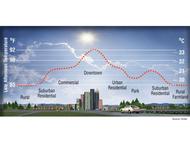The 15-Minute City - ORIGINAL CONTENT
- By:
- Edward A. Reid Jr.
- Posted On:
- Jul 11, 2023 at 7:00 AM
- Category
- Climate Change
The 15-Minute City is a relatively recent fascination of those interested in fomenting concern about climate change and using that concern to expand control over our lives.
The basic premise is a city, or section of a larger city, in which residents would have access to basic human needs including work, shopping, education, healthcare and leisure within a 15-minute walk or bicycle ride from anywhere in the city. To put that in perspective, a typical walking pace is approximately 3 miles per hour, while a typical cycling pace is approximately 15 miles per hour. Therefore, the diagonal distance between the opposite corners of a square 15-minute city would be between approximately three quarters of a mile and three and three quarters miles. If we assume that not all residents have or use bicycles, our square city would be approximately one-half mile square, or one quarter of a square mile, or approximately 5 city blocks on a side. This 15-minute city would have a population of 50,000 to 100,000, or 200,000 to 400,000 per square mile. Manhattan Island, for comparison, has a population density of approximately 74,000 per square mile and is one of the most densely populated cities in the world. Therefore, the population density of the 15-minute city would be almost 2.5 times the population density of Manhattan Island.
Activities such a manufacturing and farming would almost certainly not occur within the 15-minute city, but 15-minute cities could be constructed adjacent to manufacturing facilities or surrounded by farmland to minimize travel distances for those working in the factories or on the farms. Such cities would be reminiscent of the “company towns” built by many industrial facilities to provide employee housing and services.
The size of dwelling units would be far smaller than is currently typical in the US. For example, assuming an average occupancy of 3 persons and an average dwelling size of 600 square feet, the 15-minute city would require approximately 16,000 to 30,000 dwelling units with a total area of 10-20 million square feet in a total land area of approximately 1.7 million square feet. Assuming a 25% land area allocation for parks, recreation facilities and walking/cycling paths, plus building space allocations for offices, stores, schools, hospitals or urgent care facilities and indoor leisure facilities, the buildings in the 15-minute city would average approximately 10-20 stories.
These cities would be expected to constitute substantial urban heat islands, with average near-surface temperatures 6-8°F warmer than the surrounding rural areas. This warming would be the result of the combination of wind blocking by the multi-story buildings and heat absorption by the building mass during the day, which would be released at night, raising nighttime temperatures. The UHI effect would likely be offset somewhat by the relative absence of road surfaces and vehicle traffic.
These conditions might be relatively acceptable to current city dwellers, despite the minimal living spaces and the increased population density. However, they would likely be unpleasant for current suburban and rural dwellers.



